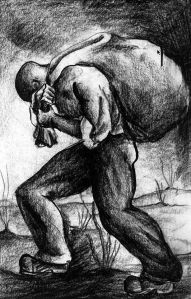
[tweetmeme source=”jjdanz” only_single=false service=bit.ly]
I’ve toiled along for the past 9+ months learning what works for me in terms of productivity. I’m feeling pretty good about that part of my writing process as I near the end of my second draft of my novel.
I also know that I’ve got so much more to learn.
I feel like I’m at the point where I can look beyond the basics of how to get my words on paper and delve into concepts that can help my writing become richer.
I want to know more about how individual writers do what they do.
There are two resources that I’ve come across in the last two weeks that have been particularly helpful: Jeff VanderMeer’s recent blog posts and Albert Zuckerman’s Writing the Blockbuster Novel. In both, authors break down their process as it relates to a particular work.
Visit Jeff VanderMeer’s site Ecstatic Days, where he has provided a look at how he decided to open Finch and the thought process that went in not only choosing when and where to begin the novel, but also where to place characters and why.
Is a lot of this “business”, like stage directions? Yes, and it’s important to get that “business” right if you want to achieve more complex effects in a novel.
Jeff VanderMeer on his blog, Ecstatic Days
If nothing else, this illustrates how much outstanding writers put into their work. While daunting, the prospect of refining and bringing out the story through more subtle techniques is exciting.
I mentioned Writing the Blockbuster Novel in a previous post, but I’m more interested in Follet’s outline process than I am in Zuckeman’s tips for writing blockbusters.
Follet’s four outlines of his book The Man from St. Petersburg show the changes he made from version to version. Instead of trying to rework the story after his first draft, he works through the story until he’s satisfied with it and then fleshes it out. His “outlines” are really summaries or synopses of the three acts of his novel. The value in this is that you minimize major reworkings after your first draft because the story has been developed to a high degree of satisfaction.
Check these guys out, if you haven’t already. What authors have inspired you as you’ve glimpsed their process?
Click here for a podcast of an interview with Albert Zuckerman that came out when an updated edition of his book was released in 2002.
Pingback: Tweets that mention How Published Authors Write « Words and Coffee -- Topsy.com
Like Follet I do a lot of preparation before I draft, and over the years have come up witha kind of working method. It’s not inspired by other novel-writers as by people in other professions who have to tackle similar problems.
So I borrow from scriptwriters to develop the story; I draw on my experiences running the subediting department of a busy newspaper to make sure there are no holes in plotting or research; I fill inspiration gaps using techniques from improvisational drama; and I tackle writer’s block with motivational techniques from sports psychology.
Roz,
Thanks for sharing your approach. I think being a well-rounded person in general can be extremely useful for not only methodology, but also for having a broader worldview from which to draw when developing your story and characters. It sounds like you’ve got it in spades. Thanks for stopping by and commenting.
This is lovely: “Instead of trying to rework the story after his first draft, he works through the story until he’s satisfied with it and then fleshes it out. His “outlines” are really summaries or synopses of the three acts of his novel.”
That’s how I do my outlines, because I have fallen in love with the three act structure. It helps me be concise in my plot and story.
I’m also working through my middle draft and instead of scraping parts and beginning again, I’m working within the framework I established at the beginning. That process has been extremely satisfying for me.
Thanks for such a great article, Jonathan!
Teresa
Glad you enjoyed the post. Follet’s approach was a revelation for me. I always thought of outlining in the traditional sense with alpha numeric structures and so on. This way allows for the flow of the story instead of worrying about heading and subheadings. It’s nice to know that this approach works for you as well. Thanks for commenting!
Pingback: Writing from an Outline (or summary, if you will. And I know you will.) « Words and Coffee